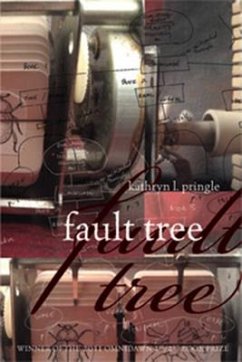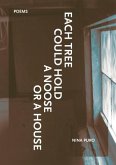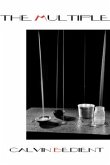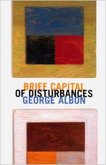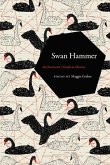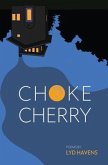Kathryn L. Pringle
Fault Tree
14,99 €
inkl. MwSt.
Versandfertig in über 4 Wochen

7 °P sammeln
Kathryn L. Pringle
Fault Tree
- Broschiertes Buch
- Merkliste
- Auf die Merkliste
- Bewerten Bewerten
- Teilen
- Produkt teilen
- Produkterinnerung
- Produkterinnerung
fault tree is a book-length poem divided into three connected effects stemming from one undesired state: time.
Andere Kunden interessierten sich auch für
![Each Tree Could Hold a Noose or a House Each Tree Could Hold a Noose or a House]() Nina PuroEach Tree Could Hold a Noose or a House14,99 €
Nina PuroEach Tree Could Hold a Noose or a House14,99 €![The Multiple The Multiple]() Calvin BedientThe Multiple14,99 €
Calvin BedientThe Multiple14,99 €![Brief Capital of Disturbances Brief Capital of Disturbances]() George AlbonBrief Capital of Disturbances13,99 €
George AlbonBrief Capital of Disturbances13,99 €![Companion Grasses Companion Grasses]() Brian TeareCompanion Grasses16,99 €
Brian TeareCompanion Grasses16,99 €![Swan Hammer: An Instructor's Guide to Mirrors Swan Hammer: An Instructor's Guide to Mirrors]() Maggie GraberSwan Hammer: An Instructor's Guide to Mirrors15,99 €
Maggie GraberSwan Hammer: An Instructor's Guide to Mirrors15,99 €![Greater Grave Greater Grave]() Jacq GreyjaGreater Grave17,99 €
Jacq GreyjaGreater Grave17,99 €![Chokecherry Chokecherry]() Lyd HavensChokecherry18,99 €
Lyd HavensChokecherry18,99 €-
-
fault tree is a book-length poem divided into three connected effects stemming from one undesired state: time.
Hinweis: Dieser Artikel kann nur an eine deutsche Lieferadresse ausgeliefert werden.
Hinweis: Dieser Artikel kann nur an eine deutsche Lieferadresse ausgeliefert werden.
Produktdetails
- Produktdetails
- Verlag: Omnidawn Publishing, Inc.
- Seitenzahl: 80
- Erscheinungstermin: 1. September 2012
- Englisch
- Abmessung: 226mm x 150mm x 10mm
- Gewicht: 159g
- ISBN-13: 9781890650704
- ISBN-10: 1890650706
- Artikelnr.: 35369176
- Herstellerkennzeichnung
- Produktsicherheitsverantwortliche/r
- Europaallee 1
- 36244 Bad Hersfeld
- gpsr@libri.de
- Verlag: Omnidawn Publishing, Inc.
- Seitenzahl: 80
- Erscheinungstermin: 1. September 2012
- Englisch
- Abmessung: 226mm x 150mm x 10mm
- Gewicht: 159g
- ISBN-13: 9781890650704
- ISBN-10: 1890650706
- Artikelnr.: 35369176
- Herstellerkennzeichnung
- Produktsicherheitsverantwortliche/r
- Europaallee 1
- 36244 Bad Hersfeld
- gpsr@libri.de
Place, time, and identity figure largely in poet KATHRYN L. PRINGLE's work. A Californian raised by Minnesotans, she grew up in the seamlessly connected neighborhoods of California's San Fernando Valley. She attended public school, played in neighborhood parks, hit the ground for drive-by shootings, and wondered at the ways in which public space and power sources were used to connect herself and her fellow inhabitants to one another. She often saw her neighborhood and her neighbors on television and this informed her notions about identity and reality--that they can be altered like suits and represented as absolutes. A drive-by shooting on the P.E. field at her sister's junior high school sent the family packing to a new world, the high desert of the Antelope Valley, and it is in this disarming and surreal landscape that pringle learned to become a writer. She attended Antelope Valley College where for many semesters she dropped all her classes except for Literature and Poetry writing. She learned that what was real was often said not to be real: the Stealth fighter, visible in the sky, but said not to exist; the sonic booms of the space shuttle landing at Edward's Air Force Base going unreported for days, only to be reported as "live" long after landing; the beauty of the desert concealing hundreds of fully operational meth labs. Charles Hood taught her about Pound and Stein and documentation. She came out of the closet. She watched her mother die. Soon, the desert became a place that she needed to escape and there were only a few ways out: pringle chose poetry. Wanting to move to a place with trees and literature, pringle applied to only one college, Sonoma State University, and was told she'd be lucky to get into it. Her grades were stellar, but her Ws outnumbered her As. Fortunately, Sonoma State accepted her, and off she went to Santa Rosa... into trees and words. It was there that she was able to match her poetry to her theories regarding identity by studying both. Gillian Conoley, DA Powell, and Terry Ehret challenged and nurtured her. She became a poet. After college, pringle attended San Francisco State University to study with Myung Mi Kim and then Stacy Doris. Myung taught her about the architecture of the poem on the page and Stacy taught her about grand plans and the enactment of ideas on the page. Dodie Bellamy taught her about moxy and gave her the books she had been missing: Microclimates, Dictee, Everybody's Autonomy, and Spoke. In a way, these three women gave pringle the "permission" she needed to write what and how she wanted to write. It was at San Francisco State that she began writing her first book, RIGHT NEW BIOLOGY (Factory School, 2009), about colonialism, manifest destiny, and the nervous system of a culture identifying as one. Soon after graduating with her MFA and MA in Poetry Writing, pringle moved to Durham, NC. It is in Durham that she ultimately learned about time: the city has lots of it and the people know how to spend it. She spent her time writing and reading and hanging out with poets Chris Vitiello, Ken Rumble, Tony Tost, Dianne Timblin, Tanya Olson, and Guillermo Parra, enjoying the many poets, speakers, artists, films, and bands that Duke and the Triangle Area attracted. Being a Californian in Durham also meant that cities like Washington D.C., Baltimore, Philadelphia, and New York were easily accessible by car. Each of these cities and the poets in them taught pringle about space and what it means to be a writer. In 2009, pringle said goodbye to Durham and headed back west to the Bay Area. She currently lives in Oakland (but works "in" Durham) with her partner, dog, and cat. Oakland's architecture and people have already inspired pringle's latest project, a novel about place--city building, urban blight, survival, and revival are featured in the work. After all, there's no escaping time and place.
